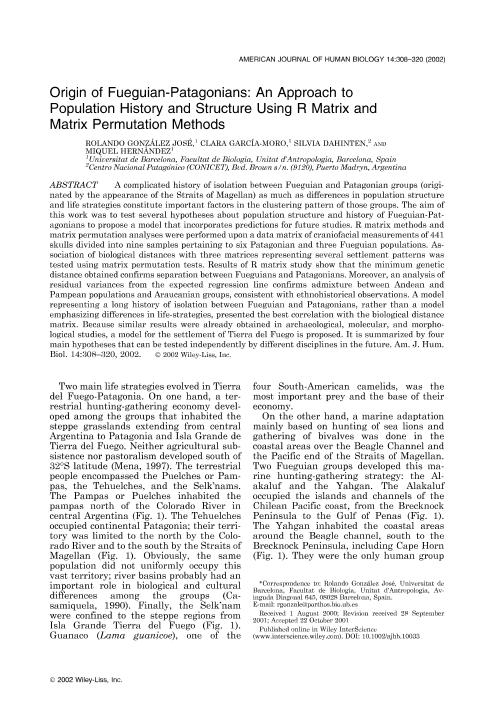Mostrar el registro sencillo del ítem
dc.contributor.author
González José, Rolando

dc.contributor.author
García Moro, Clara
dc.contributor.author
Dahinten, Silvia Lucrecia V.

dc.contributor.author
Hernández, Miquel
dc.date.available
2020-03-16T17:48:19Z
dc.date.issued
2002-12
dc.identifier.citation
González José, Rolando; García Moro, Clara; Dahinten, Silvia Lucrecia V.; Hernández, Miquel; Origin of Fueguian-Patagonians: An approach to population history and structure using R matrix and matrix permutation methods; Wiley-liss, Div John Wiley & Sons Inc; American Journal of Human Biology; 14; 3; 12-2002; 308-320
dc.identifier.issn
1042-0533
dc.identifier.uri
http://hdl.handle.net/11336/99655
dc.description.abstract
A complicated history of isolation between Fueguian and Patagonian groups (originated by the appearance of the Straits of Magellan) as much as differences in population structure and life strategies constitute important factors in the clustering pattern of those groups. The aim of this work was to test several hypotheses about population structure and history of Fueguian-Patagonians to propose a model that incorporates predictions for future studies. R matrix methods and matrix permutation analyses were performed upon a data matrix of craniofacial measurements of 441 skulls divided into nine samples pertaining to six Patagonian and three Fueguian populations. Association of biological distances with three matrices representing several settlement patterns was tested using matrix permutation tests. Results of R matrix study show that the minimum genetic distance obtained confirms separation between Fueguians and Patagonians. Moreover, an analysis of residual variances from the expected regression line confirms admixture between Andean and Pampean populations and Araucanian groups, consistent with ethnohistorical observations. A model representing a long history of isolation between Fueguian and Patagonians, rather than a model emphasizing differences in life-strategies, presented the best correlation with the biological distance matrix. Because similar results were already obtained in archaeological, molecular, and morphological studies, a model for the settlement of Tierra del Fuego is proposed. It is summarized by four main hypotheses that can be tested independently by different disciplines in the future.
dc.format
application/pdf
dc.language.iso
eng
dc.publisher
Wiley-liss, Div John Wiley & Sons Inc

dc.rights
info:eu-repo/semantics/openAccess
dc.rights.uri
https://creativecommons.org/licenses/by-nc-sa/2.5/ar/
dc.subject
FUEGIANS
dc.subject
PATAGONIANS
dc.subject.classification
Antropología, Etnología

dc.subject.classification
Sociología

dc.subject.classification
CIENCIAS SOCIALES

dc.title
Origin of Fueguian-Patagonians: An approach to population history and structure using R matrix and matrix permutation methods
dc.type
info:eu-repo/semantics/article
dc.type
info:ar-repo/semantics/artículo
dc.type
info:eu-repo/semantics/publishedVersion
dc.date.updated
2020-02-11T17:54:30Z
dc.journal.volume
14
dc.journal.number
3
dc.journal.pagination
308-320
dc.journal.pais
Estados Unidos

dc.journal.ciudad
Hoboken
dc.description.fil
Fil: González José, Rolando. Universidad de Barcelona; España. Consejo Nacional de Investigaciones Científicas y Técnicas. Centro Nacional Patagónico; Argentina
dc.description.fil
Fil: García Moro, Clara. Universidad de Barcelona; España
dc.description.fil
Fil: Dahinten, Silvia Lucrecia V.. Consejo Nacional de Investigaciones Científicas y Técnicas. Centro Nacional Patagónico; Argentina
dc.description.fil
Fil: Hernández, Miquel. Universidad de Barcelona; España
dc.journal.title
American Journal of Human Biology

dc.relation.alternativeid
info:eu-repo/semantics/altIdentifier/doi/http://dx.doi.org/10.1002/ajhb.10033
dc.relation.alternativeid
info:eu-repo/semantics/altIdentifier/url/https://onlinelibrary.wiley.com/doi/abs/10.1002/ajhb.10033
Archivos asociados
